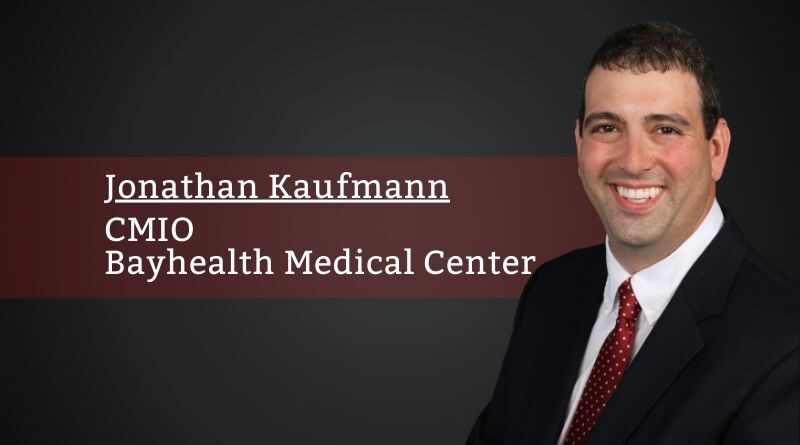Interoperability Starts Locally
By Jonathan Kaufmann, CMIO, Bayhealth Medical Center
“Hey, please stop sending me four copies of the same lab result, you’re killing me.” It’s not unusual for me to receive a text like this from a colleague on a Monday morning.
As Chief Medical Information Officer at a health system, my job is to ensure our community clinicians get the data they need, when they need it and how they need it, without duplication ─ or in the above case, quadruplication!
At the national level, the interoperability conversation has focused on promoting patient access to health information and preventing information blocking ─ critically important initiatives that will save lives. But interoperability starts locally, and here in Delaware, with our state’s robust health information exchange (HIE).
Launched in 2007, Delaware Health Information Network, or “DHIN,” as it’s commonly known, was the first operational statewide HIE in the nation. Today it serves all of Delaware’s acute care hospitals and nearly 100% of the state’s medical providers. More than 14 million clinical results and reports are delivered through DHIN each year, to community practices and health systems throughout the state. One connection to DHIN has been shown to replace more than 1,000 point-to-point interfaces.
The strong partnerships between DHIN and its data senders paid off in the early days of the pandemic when the Delaware Division of Public Health needed a daily count of COVID-19 admissions from each of the hospitals.
On a daily basis, DHIN’s team of business relationship managers visit practices throughout the state, building relationships, connecting with new staff, highlighting services and features and troubleshooting any challenges.
The combination of the relationships and the deep technical work makes DHIN the trusted source for healthcare data exchange in the state. It serves as the basis for additional services and functionality that make DE a unique place for interoperability.
In a state as small as Delaware, patients travel. The availability of patient records statewide, regardless of which health system a patient has most recently visited, is a tremendous benefit to both the treating clinician and the patient.
At the core of healthcare data exchange in Delaware is DHIN’s Community Health Record, which provides an aggregated view of a patient across geography, time and care settings. The average ambulatory practice racks up 180 views each day in treating its patients. Without this catalog readily available, requesting and collecting information from multiple sources can require 5 to 10 minutes more per chart accession.
This timely access to data improves providers’ ability to diagnose, make treatment decisions and coordinate care with others. A centralized, accessible repository also reduces unnecessary duplication of tests; in fact, an estimated 5 to 10% of tests and paid claims are avoided, at $30 per lab test and $200 per imaging exam.
For a state of fewer than one million residents, these numbers alone are impressive. But the technology is only part of the story: By identifying opportunities for improvement and collaborating to build a solution to fix them, what makes interoperability truly work is relationships.
DHIN’s relationships with stakeholders help close care gaps, particularly with underserved communities. For example, clinicians have long struggled with accessing clinical care records of skilled nursing facilities (SNF) residents, who tend to be frequent flyers in the healthcare system. By bringing together partners – a skilled nursing facility with multiple locations statewide, the national vendor who provides EMR services for that facility and the accountable care organizations (ACOs) who need this data – DHIN has recently onboarded twenty-one locations in the First State, making residents’ healthcare data accessible to the clinicians who treat them.
The strong partnerships between DHIN and its data senders paid off in the early days of the pandemic when the Delaware Division of Public Health needed a daily count of COVID-19 admissions from each of the hospitals. The statewide HIE made that possible through one automated feed, saving multiple hospital and State employees time setting up and monitoring a data feed and putting that critical information at the fingertips of the teams who needed it.
As the pandemic wore on, DHIN data was key to enriching lab results reported to the State of Delaware for improved contact tracing and other public health intervention activities. When the Division of Public Health would receive lab results missing key race and ethnicity data, that information was often found in DHIN’s Community Health Record. By matching individuals from the two data sets, DHIN supported the evaluation of disparities in impact of the virus as well as access to testing, immunization opportunity and clinical outcomes.
On a daily basis, DHIN’s team of business relationship managers visit practices throughout the state, connecting with new staff, highlighting services and features and troubleshooting any challenges. For technical support, DHIN’s Service Desk is available 8 am – 1 am, seven days a week.
My health system, Bayhealth, was early to join DHIN as a data sender, recognizing the value of a central repository and the associated savings with the delivery of results. In fact, an independent assessment estimated that DHIN’s four core services of results delivery, the Community Health Record, event notification and Clinical Gateway provide more than $43 million in value to the healthcare community annually. This equates to a return on investment of $4 for every $1 invested in DHIN.
DHIN shares real-time clinical information to improve patient outcomes, eliminate the duplication of services and reduce the cost of healthcare.
So when I receive that Monday morning text, my response is typically: “Why aren’t you working with DHIN?”



